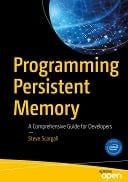
Programming Persistent Memory describes the technology and why it is exciting the industry. It covers the operating system and hardware requirements as well as how to create development environments using emulated or real persistent memory hardware.
Table of Contents
- Introduction to Persistent Memory Programming
- Persistent Memory Architecture
- Operating System Support for Persistent Memory
- Fundamental Concepts of Persistent Memory Programming
- Introducing the Persistent Memory Development Kit
- Low-Level Persistent Memory Support
- A Native Transactional Object Store
- The Adaptable Language – C++ and Persistent Memory
- A Persistent In-Memory Key-Value Store
- Volatile Use of Persistent Memory
- Designing Data Structures for Persistent Memory
- Debugging Persistent Memory Applications
- Enabling Persistence Using a Real-World Application
- Concurrency and Persistent Memory
- Profiling and Performance
- PMDK Internals: Important Algorithms and Data Structures
- Reliability, Availability, and Serviceability (RAS)
- Remote Persistent Memory
- Advanced Topics
Download Free PDF / Read Online
Author(s): Steve Scargall
Publisher: Apress
Published: January 2020
Format(s): PDF, ePub, HTML (Online)
File size: 8.86 MB(pdf)
Number of pages: 438
Download / View Link(s): PDF, ePub, HTML (Online)
Publisher: Apress
Published: January 2020
Format(s): PDF, ePub, HTML (Online)
File size: 8.86 MB(pdf)
Number of pages: 438
Download / View Link(s): PDF, ePub, HTML (Online)